Abstract
Type IV (alpha 1 and alpha 2 chains) appears to be the only procollagen present in basement membranes. The structure of this protein is highly divergent from the interstitial and type V procollagens as exemplified by the interruptions in the Gly-X-Y region and unprocessed amino and carboxyl noncollagenous peptides. To expand our knowledge concerning the primary sequence of type IV and to investigate the factors influencing its unique distribution, we recently isolated cDNA clones coding for part of the human alpha 1(IV) chain. To determine if the alpha 1(IV) gene was cytologically linked to other procollagen genes that have been assigned to autosomes 17, 12, 7, and 2, overlapping clones covering 2.6 kilobases (kb) of the alpha 1(IV) mRNA were used together for in situ hybridization to human metaphase chromosomes. Here, we show precise localization of alpha 1(IV) at the telomere of 13q, thereby defining a fifth chromosome that contains members of this large and surprisingly dispersed multigene family.
Full text
PDF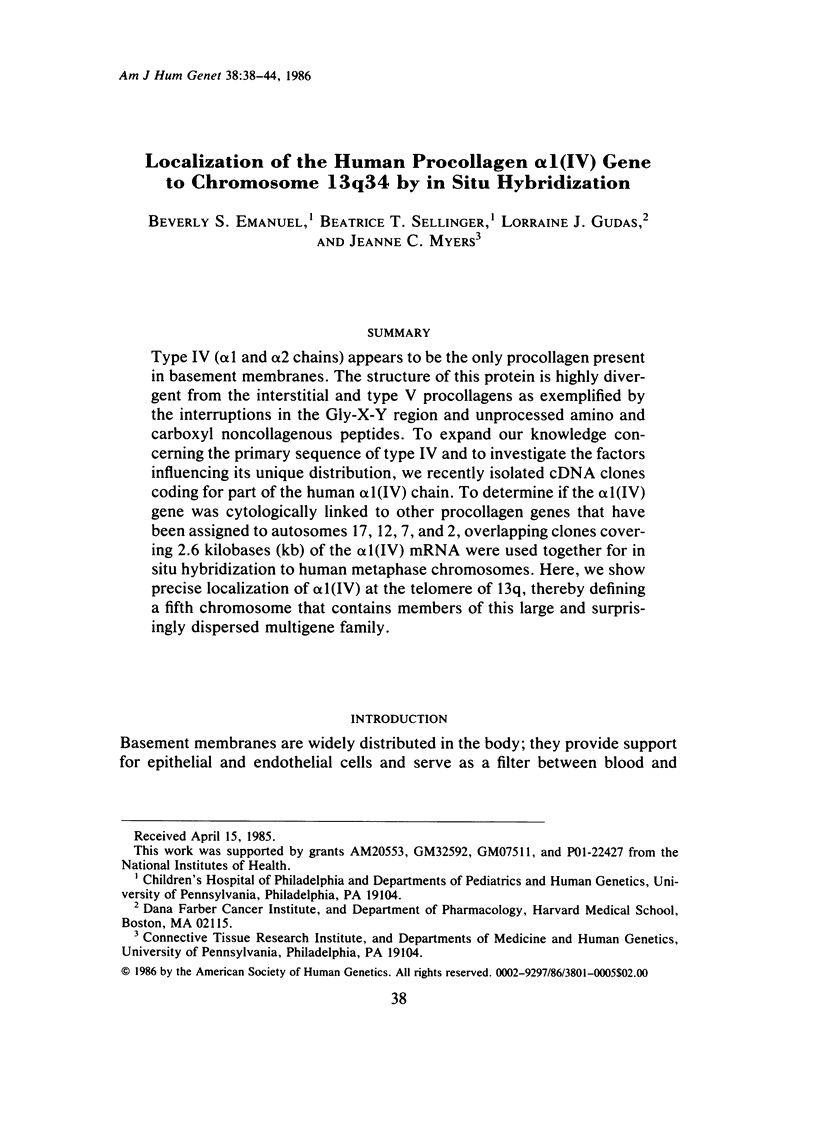

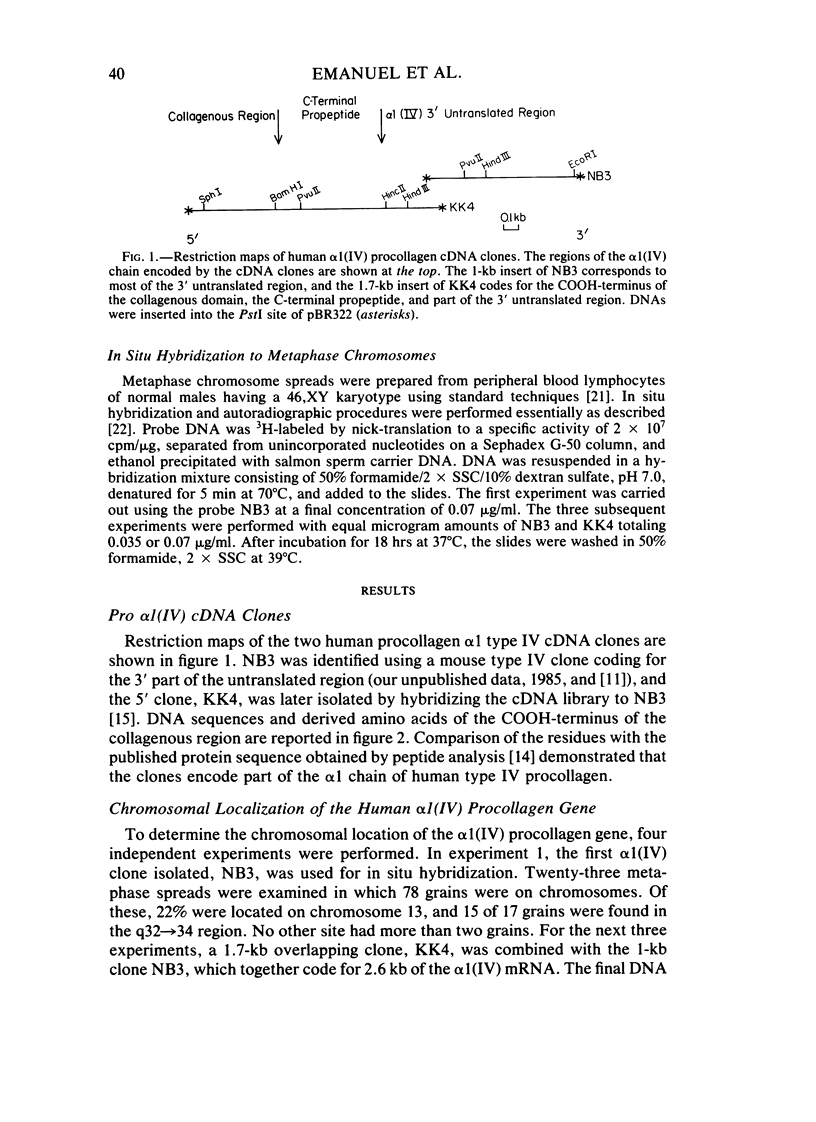
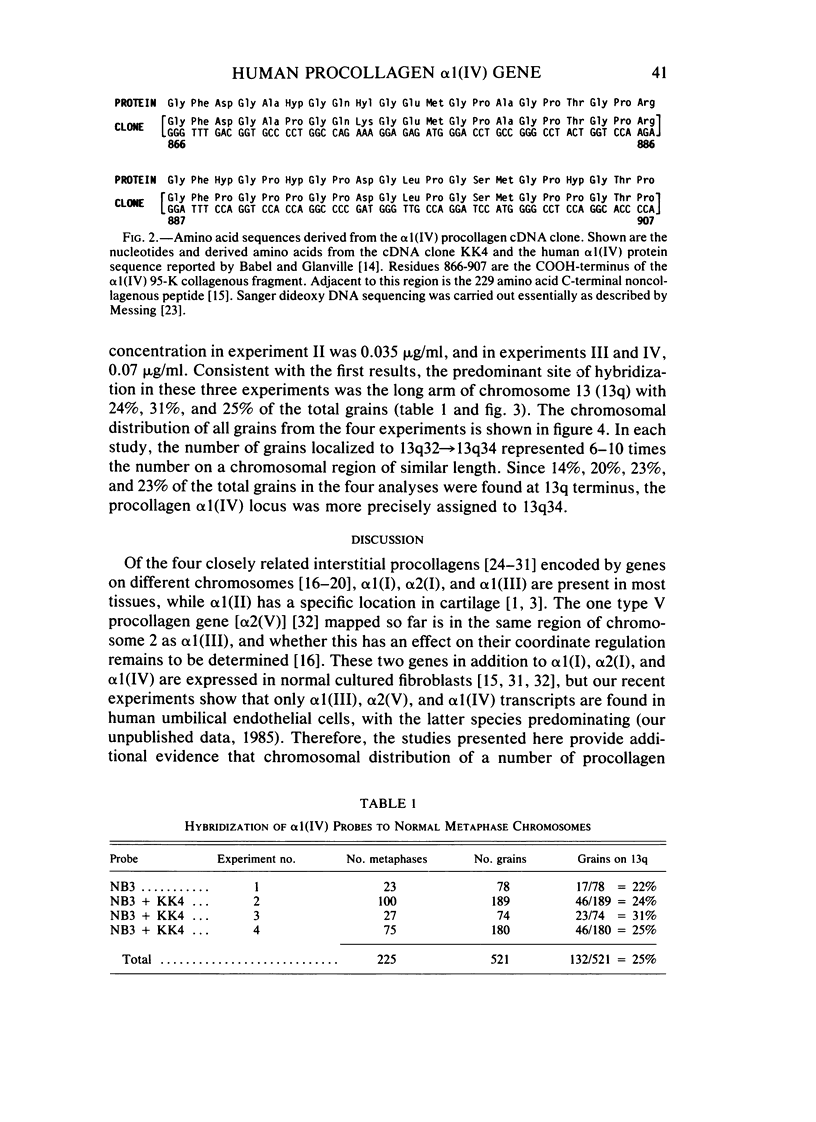
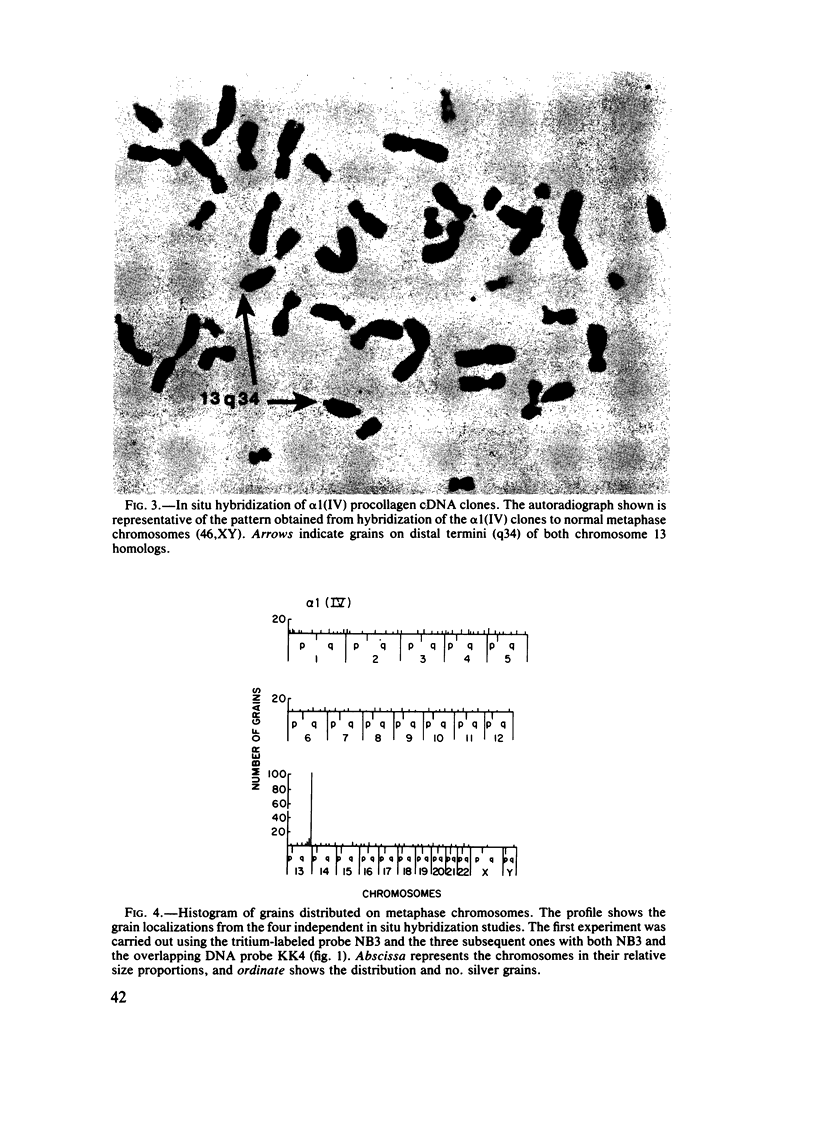
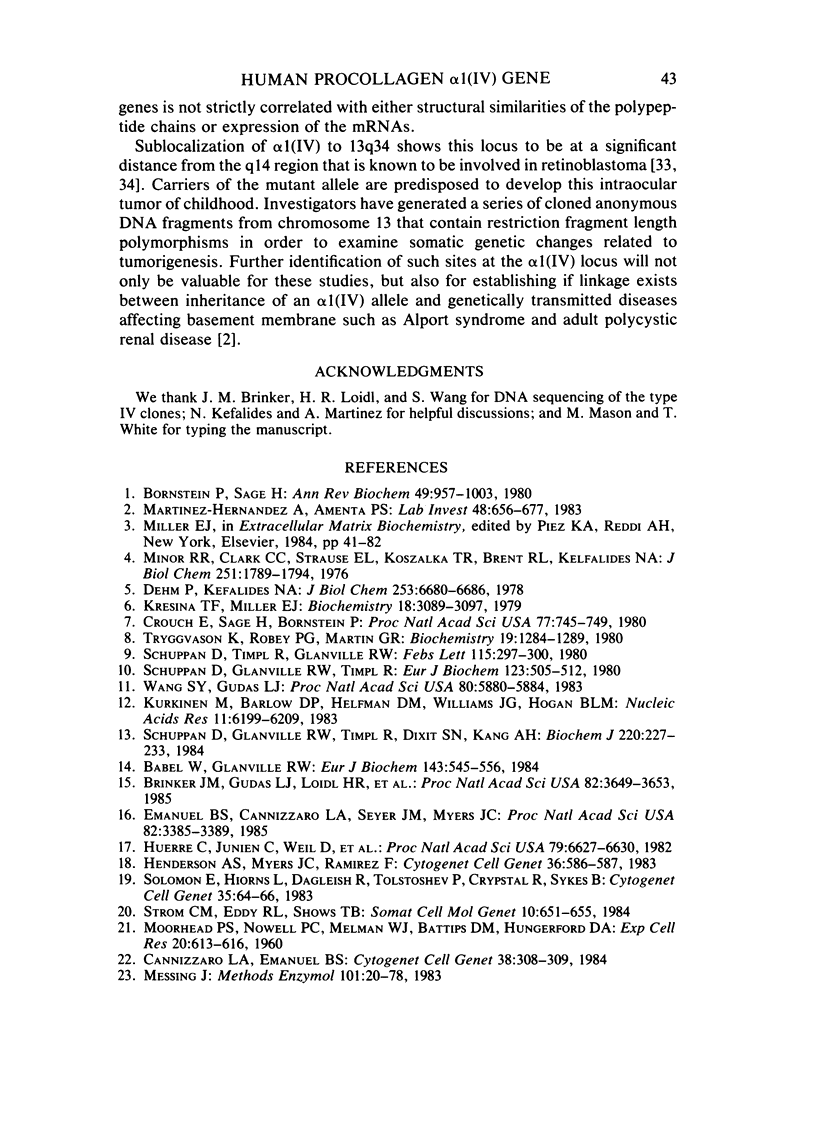
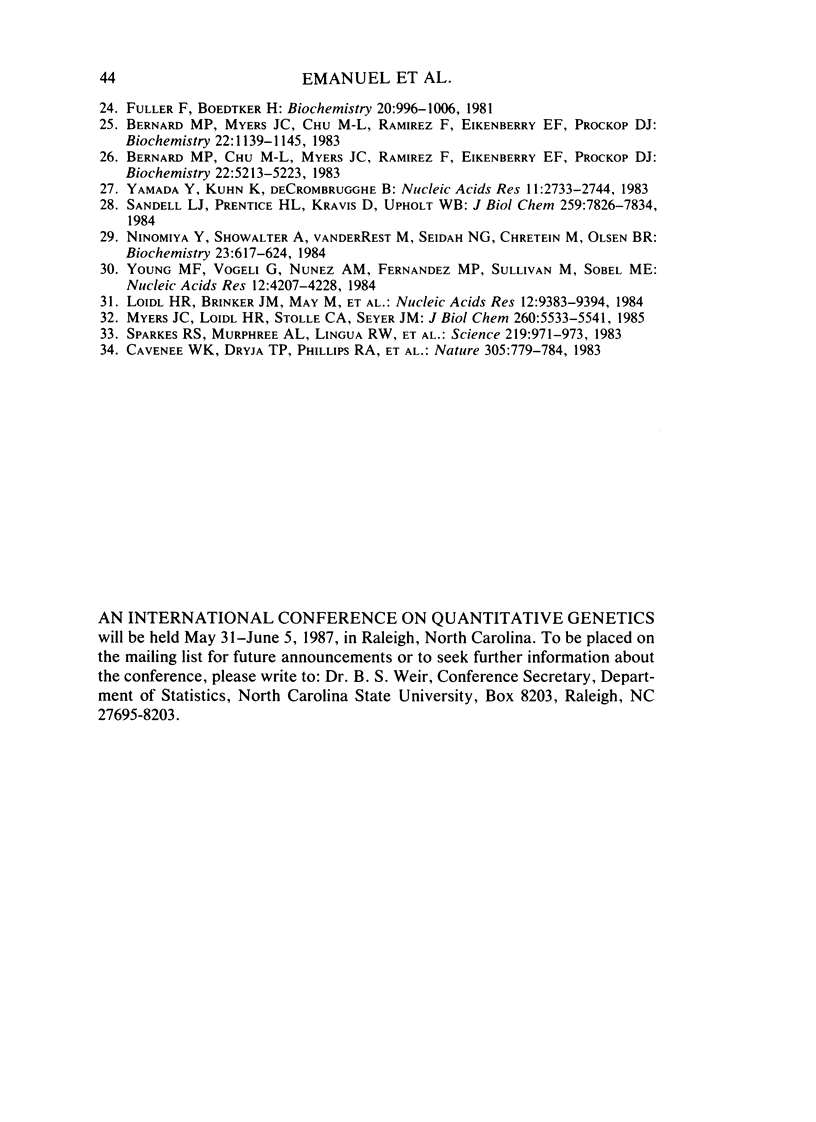
Images in this article
Selected References
These references are in PubMed. This may not be the complete list of references from this article.
- Bernard M. P., Chu M. L., Myers J. C., Ramirez F., Eikenberry E. F., Prockop D. J. Nucleotide sequences of complementary deoxyribonucleic acids for the pro alpha 1 chain of human type I procollagen. Statistical evaluation of structures that are conserved during evolution. Biochemistry. 1983 Oct 25;22(22):5213–5223. doi: 10.1021/bi00291a023. [DOI] [PubMed] [Google Scholar]
- Bernard M. P., Myers J. C., Chu M. L., Ramirez F., Eikenberry E. F., Prockop D. J. Structure of a cDNA for the pro alpha 2 chain of human type I procollagen. Comparison with chick cDNA for pro alpha 2(I) identifies structurally conserved features of the protein and the gene. Biochemistry. 1983 Mar 1;22(5):1139–1145. doi: 10.1021/bi00274a023. [DOI] [PubMed] [Google Scholar]
- Brinker J. M., Gudas L. J., Loidl H. R., Wang S. Y., Rosenbloom J., Kefalides N. A., Myers J. C. Restricted homology between human alpha 1 type IV and other procollagen chains. Proc Natl Acad Sci U S A. 1985 Jun;82(11):3649–3653. doi: 10.1073/pnas.82.11.3649. [DOI] [PMC free article] [PubMed] [Google Scholar]
- Cavenee W. K., Dryja T. P., Phillips R. A., Benedict W. F., Godbout R., Gallie B. L., Murphree A. L., Strong L. C., White R. L. Expression of recessive alleles by chromosomal mechanisms in retinoblastoma. 1983 Oct 27-Nov 2Nature. 305(5937):779–784. doi: 10.1038/305779a0. [DOI] [PubMed] [Google Scholar]
- Dehm P., Kefalides N. A. The collagenous component of lens basement membrane. The isolation and characterization of an alpha chain size collagenous peptide and its relationship to newly synthesized lens components. J Biol Chem. 1978 Oct 10;253(19):6680–6686. [PubMed] [Google Scholar]
- Emanuel B. S., Cannizzaro L. A., Seyer J. M., Myers J. C. Human alpha 1(III) and alpha 2(V) procollagen genes are located on the long arm of chromosome 2. Proc Natl Acad Sci U S A. 1985 May;82(10):3385–3389. doi: 10.1073/pnas.82.10.3385. [DOI] [PMC free article] [PubMed] [Google Scholar]
- Fuller F., Boedtker H. Sequence determination and analysis of the 3' region of chicken pro-alpha 1(I) and pro-alpha 2(I) collagen messenger ribonucleic acids including the carboxy-terminal propeptide sequences. Biochemistry. 1981 Feb 17;20(4):996–1006. doi: 10.1021/bi00507a054. [DOI] [PubMed] [Google Scholar]
- Huerre C., Junien C., Weil D., Chu M. L., Morabito M., Van Cong N., Myers J. C., Foubert C., Gross M. S., Prockop D. J. Human type I procollagen genes are located on different chromosomes. Proc Natl Acad Sci U S A. 1982 Nov;79(21):6627–6630. doi: 10.1073/pnas.79.21.6627. [DOI] [PMC free article] [PubMed] [Google Scholar]
- Kurkinen M., Barlow D. P., Helfman D. M., Williams J. G., Hogan B. L. Isolation of cDNA clones for basal lamina components: type IV procollagen. Nucleic Acids Res. 1983 Sep 24;11(18):6199–6209. doi: 10.1093/nar/11.18.6199. [DOI] [PMC free article] [PubMed] [Google Scholar]
- Loidl H. R., Brinker J. M., May M., Pihlajaniemi T., Morrow S., Rosenbloom J., Myers J. C. Molecular cloning and carboxyl-propeptide analysis of human type III procollagen. Nucleic Acids Res. 1984 Dec 21;12(24):9383–9394. doi: 10.1093/nar/12.24.9383. [DOI] [PMC free article] [PubMed] [Google Scholar]
- MOORHEAD P. S., NOWELL P. C., MELLMAN W. J., BATTIPS D. M., HUNGERFORD D. A. Chromosome preparations of leukocytes cultured from human peripheral blood. Exp Cell Res. 1960 Sep;20:613–616. doi: 10.1016/0014-4827(60)90138-5. [DOI] [PubMed] [Google Scholar]
- Martinez-Hernandez A., Amenta P. S. The basement membrane in pathology. Lab Invest. 1983 Jun;48(6):656–677. [PubMed] [Google Scholar]
- Messing J. New M13 vectors for cloning. Methods Enzymol. 1983;101:20–78. doi: 10.1016/0076-6879(83)01005-8. [DOI] [PubMed] [Google Scholar]
- Minor R. R., Clark C. C., Strause E. L., Koszalka T. R., Brent R. L., Kefalides N. A. Basement membrane procollagen is not converted to collagen in organ cultures of parietal yolk sac endoderm. J Biol Chem. 1976 Mar 25;251(6):1789–1794. [PubMed] [Google Scholar]
- Myers J. C., Loidl H. R., Stolle C. A., Seyer J. M. Partial covalent structure of the human alpha 2 type V collagen chain. J Biol Chem. 1985 May 10;260(9):5533–5541. [PubMed] [Google Scholar]
- Sandell L. J., Prentice H. L., Kravis D., Upholt W. B. Structure and sequence of the chicken type II procollagen gene. Characterization of the region encoding the carboxyl-terminal telopeptide and propeptide. J Biol Chem. 1984 Jun 25;259(12):7826–7834. [PubMed] [Google Scholar]
- Schuppan D., Glanville R. W., Timpl R., Dixit S. N., Kang A. H. Sequence comparison of pepsin-resistant segments of basement-membrane collagen alpha 1(IV) chains from bovine lens capsule and mouse tumour. Biochem J. 1984 May 15;220(1):227–233. doi: 10.1042/bj2200227. [DOI] [PMC free article] [PubMed] [Google Scholar]
- Solomon E., Hiorns L., Dalgleish R., Tolstoshev P., Crystal R., Sykes B. Regional localization of the human alpha 2(I) collagen gene on chromosome 7 by molecular hybridization. Cytogenet Cell Genet. 1983;35(1):64–66. doi: 10.1159/000131838. [DOI] [PubMed] [Google Scholar]
- Sparkes R. S., Murphree A. L., Lingua R. W., Sparkes M. C., Field L. L., Funderburk S. J., Benedict W. F. Gene for hereditary retinoblastoma assigned to human chromosome 13 by linkage to esterase D. Science. 1983 Feb 25;219(4587):971–973. doi: 10.1126/science.6823558. [DOI] [PubMed] [Google Scholar]
- Tryggvason K., Robey P. G., Martin G. R. Biosynthesis of type IV procollagens. Biochemistry. 1980 Apr 1;19(7):1284–1289. doi: 10.1021/bi00548a003. [DOI] [PubMed] [Google Scholar]
- Wang S. Y., Gudas L. J. Isolation of cDNA clones specific for collagen IV and laminin from mouse teratocarcinoma cells. Proc Natl Acad Sci U S A. 1983 Oct;80(19):5880–5884. doi: 10.1073/pnas.80.19.5880. [DOI] [PMC free article] [PubMed] [Google Scholar]
- Young M. F., Vogeli G., Nunez A. M., Fernandez M. P., Sullivan M., Sobel M. E. Isolation of cDNA and genomic DNA clones encoding type II collagen. Nucleic Acids Res. 1984 May 25;12(10):4207–4228. doi: 10.1093/nar/12.10.4207. [DOI] [PMC free article] [PubMed] [Google Scholar]



